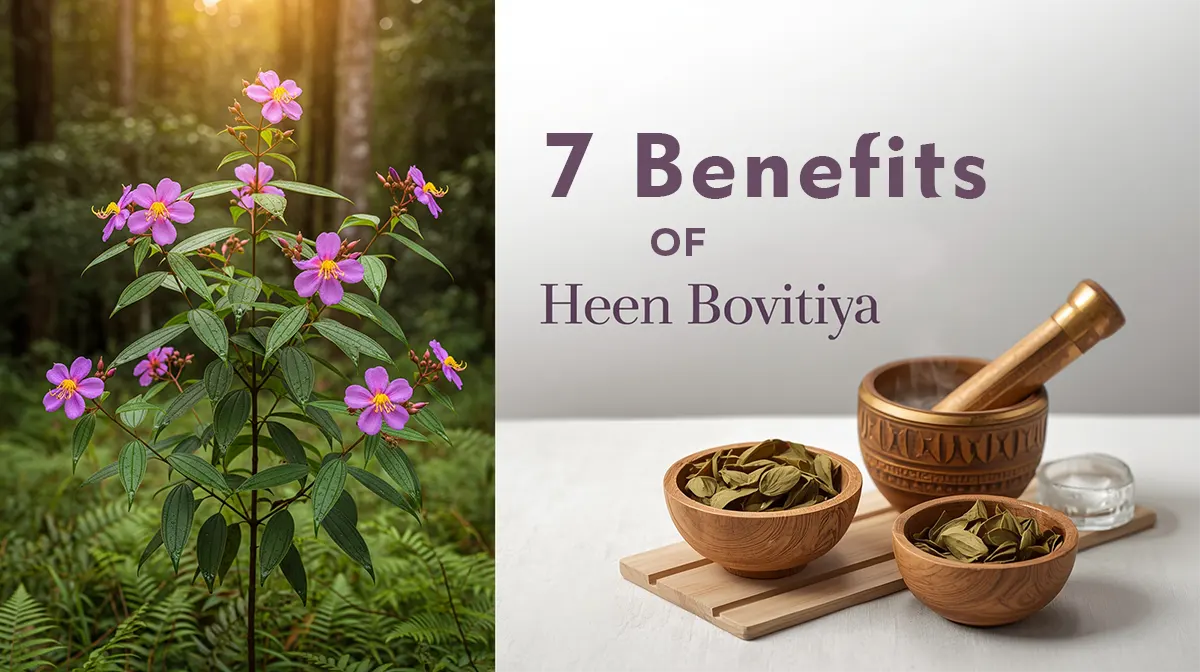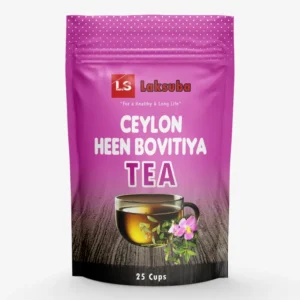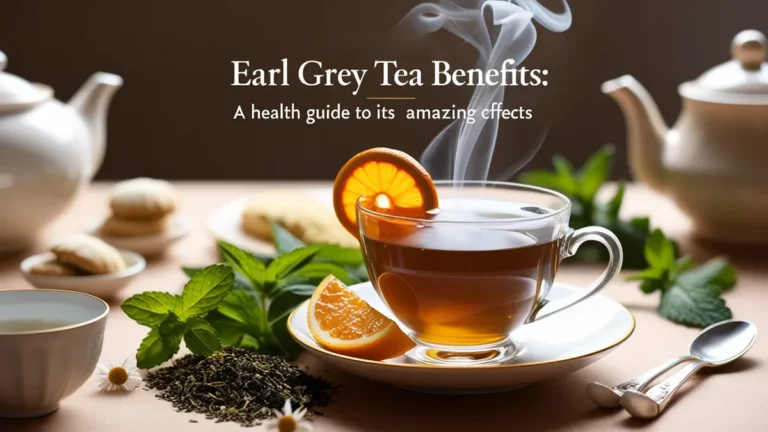Heen Bovitiya (Osbeckia octandra): A Complete Guide
Introduction
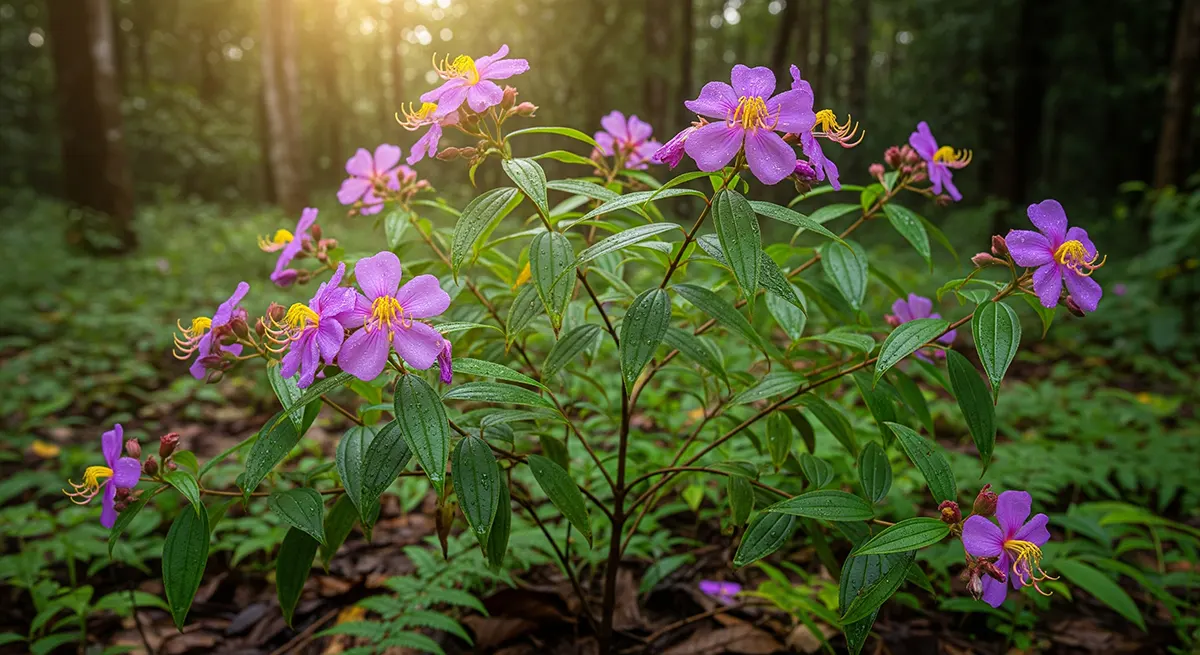
Heen Bovitiya is one of Sri Lanka’s most valuable medicinal plants. Its scientific name is Osbeckia octandra. This plant belongs to the Melastomataceae family. It grows only in Sri Lanka, making it an endemic species.
Traditional healers have used this plant for centuries. Modern science now confirms many of its healing properties. The plant serves as an important part of Ayurvedic medicine. It also represents Sri Lanka’s rich plant diversity.
Scientific Classification
Osbeckia octandra has a clear position in plant science. It belongs to the Kingdom Plantae. The family name is Melastomataceae. The genus is Osbeckia.
The species name “octandra” comes from Latin. It means “eight stamens,” referring to the flower’s structure. Augustin Pyramus de Candolle first described this plant scientifically. He added “DC” to the scientific name as his author abbreviation.
Common Names
People in Sri Lanka know this plant by different names. The most common Sinhala name is “Heen Bovitiya.” Some people simply call it “Bovitiya.” Ancient texts sometimes refer to it as “Kuruvina.”
In English, some call it the “eight stamen osbeckia.” This name describes its unique flower structure. However, the Sinhala names remain more commonly used.
Physical Description
Overall Appearance
Heen Bovitiya grows as a branched shrub. It can reach up to 2 meters in height. The plant has an upright growth pattern. Multiple branches spread from the main stem.
The entire plant has tiny hair-like structures. These hairs give the plant a rough texture. They help protect the plant from insects and water loss.
Leaves
The leaves measure 1.5 to 6 centimeters long. Their width ranges from 0.5 to 2 centimeters. The leaves arrange themselves alternately on the branches. This pattern helps each leaf get enough sunlight.
Each leaf has three main veins. The central vein is the most visible. Two other veins run parallel on each side. The upper leaf surface appears dark green. The lower surface is lighter green with more tiny hairs.
Flowers
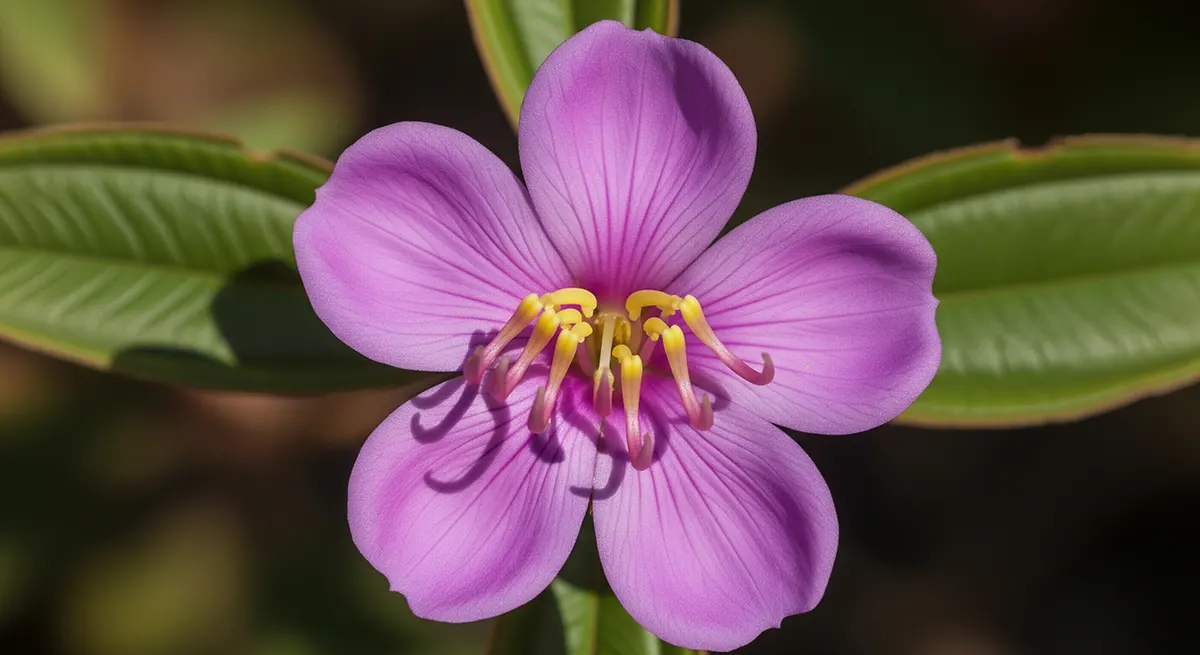
The flowers are the plant’s most beautiful feature. They grow in small groups at branch tips. Each group contains up to ten flowers.
Individual flowers measure about 2 centimeters across. They have five petals, each 15 to 19 millimeters long. The petals show lovely pink to purple colors. The flower center contains bright yellow pollen. This color contrast attracts bees and other pollinators.
The petals feel smooth and slightly thick. Their edges fold outward from the center. Flowers appear several times throughout the year.
Fruits and Seeds
After flowering, the plant produces small dry capsules. These capsules contain many tiny seeds. Each seed measures less than half a millimeter. The seeds have a curved shape with a bumpy surface.
Where It Grows
Geographic Range
Osbeckia octandra grows naturally only in Sri Lanka. Some reports suggest it might also grow in Tamil Nadu, India. However, Sri Lanka remains its primary home.
Within Sri Lanka, the plant grows in specific climate zones. It prefers the wet and intermediate zones. These areas receive regular rainfall throughout the year.
Habitat Preferences
The plant likes forest edges and open woodlands. It also grows in scrublands and grassland borders. You can find it on hillsides and mountain slopes.
Heen Bovitiya grows best between 600 and 1700 meters above sea level. It prefers areas with good drainage. The plant often appears in rock crevices and earth cuttings.
After monsoon rains, new plants quickly colonize bare soil. This shows the plant’s ability to spread rapidly. It often grows alongside other native Sri Lankan plants.
Soil Requirements
The plant grows well in lateritic soils. These are iron-rich, reddish soils common in tropical areas. It can also grow in rocky areas with little soil. Good drainage is essential for healthy growth.
Chemical Composition
Major Compound Groups
Scientists have identified many beneficial chemicals in Heen Bovitiya. These compounds give the plant its healing properties.
Phenolic Compounds: The plant contains very high levels of phenolic compounds. These chemicals act as powerful antioxidants. They help protect cells from damage.
Flavonoids: These are special types of phenolic compounds. They have strong anti-inflammatory effects. Flavonoids also help strengthen blood vessels.
Tannins: These compounds give the plant its astringent taste. They help stop bleeding and reduce inflammation. Tannins also have antimicrobial properties.
Terpenoids: These are aromatic compounds with various effects. They contribute to the plant’s medicinal properties. Some terpenoids have anti-cancer activity.
Alkaloids: These nitrogen-containing compounds affect the nervous system. They can reduce pain and inflammation. Some alkaloids also have antimicrobial effects.
Saponins: These compounds create foam when mixed with water. They help the body absorb other medicines. Saponins also have cholesterol-lowering effects.
Phytosterols: These are plant versions of cholesterol. They help reduce bad cholesterol in humans. Phytosterols also have anti-inflammatory properties.
Antioxidant Power
Heen Bovitiya has exceptional antioxidant capacity. Antioxidants protect our cells from damage. They neutralize harmful free radicals in the body.
Laboratory tests show remarkable antioxidant activity. The plant’s antioxidant power exceeds many other medicinal plants. This high antioxidant content contributes to its healing effects.
Traditional Medicine Uses
Historical Background
Sri Lankan traditional healers have used Heen Bovitiya for generations. The plant appears in ancient Ayurvedic texts. Village healers pass down knowledge about its uses.
Traditional medicine recognizes both food and medicine uses. Young leaves serve as a nutritious vegetable. Mature leaves, roots, and bark provide medicine.
Liver Diseases
The most important traditional use treats liver problems. Healers prescribe it for various liver conditions:
Hepatitis Treatment: Traditional practitioners use leaf extracts for liver inflammation. They prepare special mixtures for hepatitis patients. The treatment usually continues for several weeks.
Jaundice Relief: Yellow skin and eyes indicate jaundice. Heen Bovitiya helps restore normal liver function. Patients drink herbal tea made from the leaves.
Cirrhosis Management: This serious liver disease causes scarring. Traditional medicine uses the plant to slow disease progression. Regular consumption may help protect remaining liver tissue.
Fatty Liver: Modern lifestyles often cause fatty liver disease. Traditional healers recommend Heen Bovitiya tea. It helps reduce fat accumulation in the liver.
Diabetes Treatment
Traditional medicine uses mature leaves for diabetes. Patients drink herbal tea three times daily. The tea helps control blood sugar levels.
Healers recommend drinking the tea before meals. This timing helps reduce sugar absorption. Many diabetes patients report improved energy levels.
Digestive Problems
The plant treats several digestive issues:
Hemorrhoids: The astringent properties reduce swelling. Patients use both internal and external preparations. The treatment helps stop bleeding and reduce pain.
Fluid Retention: Ascites causes fluid buildup in the abdomen. Heen Bovitiya helps remove excess fluid. It supports kidney and liver function.
Traditional Preparation Methods
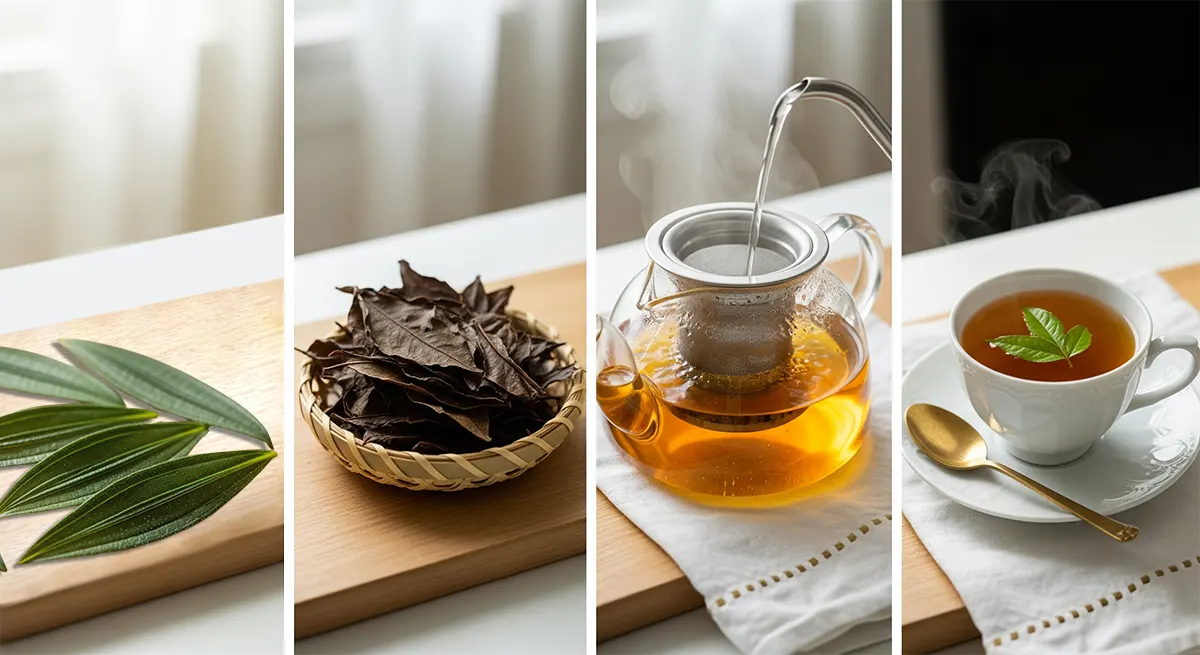
Different preparations suit different conditions:
Herbal Tea: Dried leaves steep in hot water for 10 minutes. Patients drink this tea two to three times daily. This is the most common preparation method.
Fresh Leaf Juice: Fresh leaves are crushed and strained. The juice provides concentrated active compounds. Healers prescribe it for acute conditions.
Leaf Porridge: Young leaves cook with rice or other grains. This provides both nutrition and medicine. Families often eat this during illness recovery.
Root Decoctions: Roots boil in water for 20 minutes. The resulting liquid treats severe liver problems. This preparation is stronger than leaf tea.
Scientific Research Findings
Liver Protection Studies
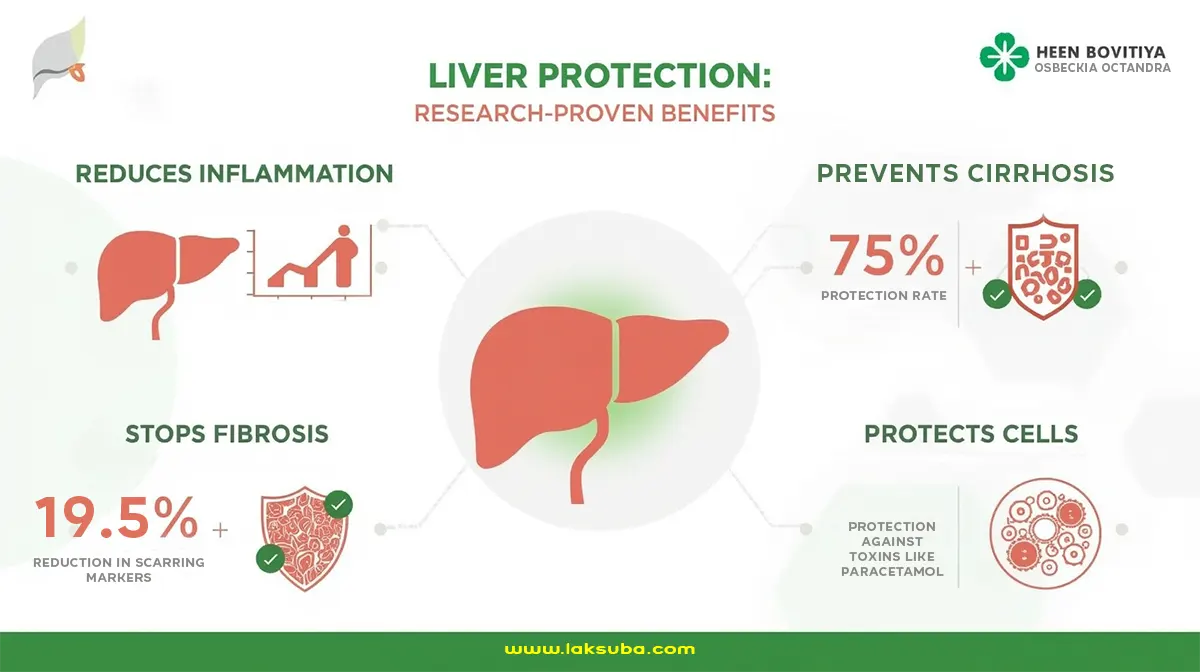
Modern research strongly supports traditional liver uses. Scientists tested the plant using animal models. The results show impressive liver protection.
Cirrhosis Prevention: Studies used chemicals that cause liver cirrhosis in rats. Heen Bovitiya extracts prevented much of the damage. Treated animals showed less scarring and better liver function.
Inflammation Reduction: The plant reduces inflammatory chemicals in the liver. It decreases tumor necrosis factor levels significantly. Lower inflammation means less liver damage.
Fibrosis Prevention: Liver fibrosis involves excessive scar tissue formation. The plant reduces proteins that cause scarring. It helps maintain normal liver structure.
Cell Protection: Heen Bovitiya protects liver cells from toxins. Studies tested it against paracetamol overdose damage. The plant extracts prevented cell death effectively.
Cancer Research
Recent studies revealed anti-cancer properties. Research focused on oral cancer cells. The findings show promising results.
Cancer Cell Death: The plant extract kills cancer cells selectively. Normal cells remain unharmed at the same doses. This selective action is crucial for safe treatment.
Growth Inhibition: Cancer cells stop multiplying when treated. The extract blocks DNA replication in cancer cells. This prevents tumor growth and spread.
Programmed Cell Death: The plant triggers apoptosis in cancer cells. Apoptosis is the body’s natural way to eliminate damaged cells. The extract activates this process specifically in cancer cells.
Cell Cycle Arrest: Cancer cells get stuck in their growth cycle. They cannot complete division and eventually die. This mechanism adds to the anti-cancer effects.
Antioxidant Studies
Laboratory tests confirm powerful antioxidant activity. The plant neutralizes various types of free radicals. These antioxidants protect cells throughout the body.
Free radicals cause aging and disease. Heen Bovitiya’s antioxidants neutralize these harmful molecules. This protection may prevent many chronic diseases.
Diabetes Research
Scientific studies support traditional diabetes use. The plant helps control blood sugar levels. It may improve insulin function.
Animal studies show reduced blood glucose. The effect appears within hours of consumption. Regular use maintains better glucose control.
Current Clinical Trials
Fatty Liver Disease Study
A major clinical trial is currently underway. Researchers are testing Heen Bovitiya tea in fatty liver patients. This study bridges traditional medicine and modern science.
Study Design: Patients receive either herbal tea or standard treatment. The tea contains 6 grams of dried plant powder. Participants drink it three times weekly.
Measurements: Doctors use special scans to measure liver fat. They also check liver stiffness and scarring. Blood tests monitor liver function markers.
Patient Selection: The study includes overweight and diabetic patients. All participants have ultrasound-confirmed fatty liver. The trial excludes patients with severe liver disease.
Expected Outcomes: Researchers expect reduced liver fat content. They also anticipate improved liver function tests. The study may validate traditional uses scientifically.
Safety Information
Toxicity Studies
Research shows Heen Bovitiya is generally safe. Animal studies found no toxic effects at normal doses. Even high doses caused no serious problems.
Mice received up to 2000 mg per kilogram body weight. This is much higher than traditional doses. No animals showed signs of poisoning.
Long-term studies gave daily doses for months. Animals remained healthy throughout the treatment. Their organs showed no damage when examined.
Cancer Cell Selectivity
The plant shows remarkable safety in cancer studies. It kills cancer cells but spares normal cells. This selectivity is unusual and valuable.
Normal human cells tolerate the extract well. Only cancer cells show toxic effects. This suggests potential for safe cancer treatment.
Precautions
Despite good safety data, some precautions apply:
Pregnant women should consult healthcare providers first. Breastfeeding mothers need medical advice before use. People with severe liver disease require medical supervision.
Start with small doses to check for allergies. Some people may be sensitive to plant compounds. Stop use if any unusual symptoms occur.
Conservation Status
Current Status
Heen Bovitiya is classified as “Least Concern” in Sri Lanka. This means the species is not immediately threatened. However, this status requires regular monitoring.
The plant maintains stable populations in suitable habitats. It grows in multiple locations across the country. Natural reproduction appears adequate currently.
Threats
Several factors could affect future survival:
Habitat Loss: Development destroys natural growing areas. Roads and buildings replace forest edges. Urban expansion reduces suitable habitats.
Climate Change: Changing rainfall patterns affect growth. Temperature increases may shift suitable zones. Extreme weather events damage populations.
Over-harvesting: Increasing demand could threaten wild plants. Commercial collection needs careful management. Sustainable harvesting practices are essential.
Invasive Species: Non-native plants compete for space. Some invasive species grow faster and larger. They may crowd out native Heen Bovitiya plants.
Conservation Measures
Several strategies help protect the species:
Botanical Gardens: Many gardens now grow Heen Bovitiya. This preserves genetic diversity safely. Gardens also educate visitors about the plant.
Cultivation Programs: Teaching farmers to grow the plant reduces wild harvesting. Commercial cultivation meets market demand. This provides income while protecting wild populations.
Research: Scientists study the plant’s ecology and needs. This knowledge guides conservation efforts. Research also develops better growing methods.
Education: Public awareness programs highlight the plant’s value. Communities learn sustainable harvesting methods. School programs teach children about endemic plants.
Growing Heen Bovitiya
Seed Propagation
Growing from seeds is possible but challenging. Fresh seeds germinate better than stored ones. Success rates vary from 30 to 60 percent.
Seed Collection: Collect ripe capsules before they open. Extract seeds carefully to avoid damage. Use seeds within a few weeks for best results.
Planting Medium: Mix equal parts sand and garden soil. This combination provides good drainage and nutrients. Keep the medium moist but not waterlogged.
Germination Conditions: Seeds need warm temperatures to germinate. Provide partial shade during germination. Seedlings appear within 2 to 4 weeks.
Stem Cutting Method
Stem cuttings offer better success than seeds. This method produces plants identical to the parent. Success rates reach 70 to 80 percent.
Cutting Selection: Choose semi-hardwood stems for best results. Cut 10 to 15 centimeter pieces with several nodes. Remove lower leaves to prevent rotting.
Rooting Hormone: Dip cut ends in rooting hormone powder. Commercial IBA products work well. This treatment doubles rooting success.
Planting Mix: Combine equal parts compost and coir dust. This mixture holds moisture while allowing drainage. Place cuttings 5 centimeters deep in the medium.
Care: Keep cuttings in partial shade initially. Maintain consistent moisture without overwatering. Roots develop within 3 to 4 weeks.
Tissue Culture
Laboratory propagation produces many plants quickly. This method requires specialized equipment and skills. Success rates exceed 90 percent.
Scientists grow plant cells in sterile containers. Special nutrients feed the developing plants. This method produces disease-free plants rapidly.
Tissue culture suits commercial production needs. It ensures uniform plant quality. However, small farmers cannot use this method.
Growing Conditions
Light Requirements: Heen Bovitiya needs partial to full sunlight. Too much shade reduces flowering. Morning sun with afternoon shade works well.
Water Needs: Provide regular water during dry periods. The plant tolerates brief dry spells. Overwatering causes root rot problems.
Soil Preparation: Add compost to improve soil structure. Ensure good drainage to prevent waterlogging. Slightly acidic soil promotes healthy growth.
Fertilization: Apply balanced fertilizer monthly during growing season. Organic fertilizers work well. Avoid excessive nitrogen which reduces flowering.
Pruning: Trim plants to maintain bushy growth. Remove dead or damaged branches promptly. Pruning encourages more flowering shoots.
Ornamental Uses
Garden Applications
Heen Bovitiya makes an attractive garden plant. Its purple flowers add color to landscapes. The plant fits well in various garden styles.
Border Plantings: Use as a medium-height border plant. It creates natural-looking edges along paths. The spreading habit fills spaces nicely.
Mixed Beds: Combine with other native plants. It complements both flowering and foliage plants. The fine texture contrasts with bold-leaved plants.
Rock Gardens: Plant in crevices between rocks. It naturally grows in rocky habitats. The plant softens hard landscape features.
Container Growing: Grow in large pots for patios. This allows easy movement and care. Container plants need more frequent watering.
Landscape Benefits
Pollinator Support: Flowers attract bees and butterflies. This supports local ecosystem health. Gardens become more environmentally friendly.
Native Plant Gardens: Perfect for Sri Lankan native plant collections. It represents local biodiversity. Native gardens require less maintenance.
Erosion Control: The spreading root system stabilizes soil. Plant on slopes to prevent erosion. It works well on embankments.
Educational Value: Teaches people about medicinal plants. Schools can grow it in educational gardens. Children learn about traditional medicine and conservation.
Flowering Patterns
Heen Bovitiya flowers multiple times yearly. Peak flowering occurs after rain periods. Flowers last several days on the plant.
Regular pruning extends the flowering period. Remove spent flowers to encourage new blooms. Well-maintained plants flower almost continuously.
The purple flowers follow Royal Horticultural Society color standards. They register as purple group 77A on official charts. This consistent color makes garden planning easier.
Commercial Potential
Pharmaceutical Industry
Drug companies show increasing interest in Heen Bovitiya. The proven liver protection effects have commercial value. Several products are under development.
Standardized Extracts: Companies develop consistent extract preparations. These ensure reliable therapeutic effects. Quality control measures guarantee safety.
Liver Health Supplements: Dietary supplements target liver health markets. Products combine Heen Bovitiya with other herbs. The global liver supplement market continues growing.
Research Partnerships: Universities collaborate with pharmaceutical companies. They investigate new therapeutic applications. Patent applications protect novel discoveries.
Herbal Tea Market
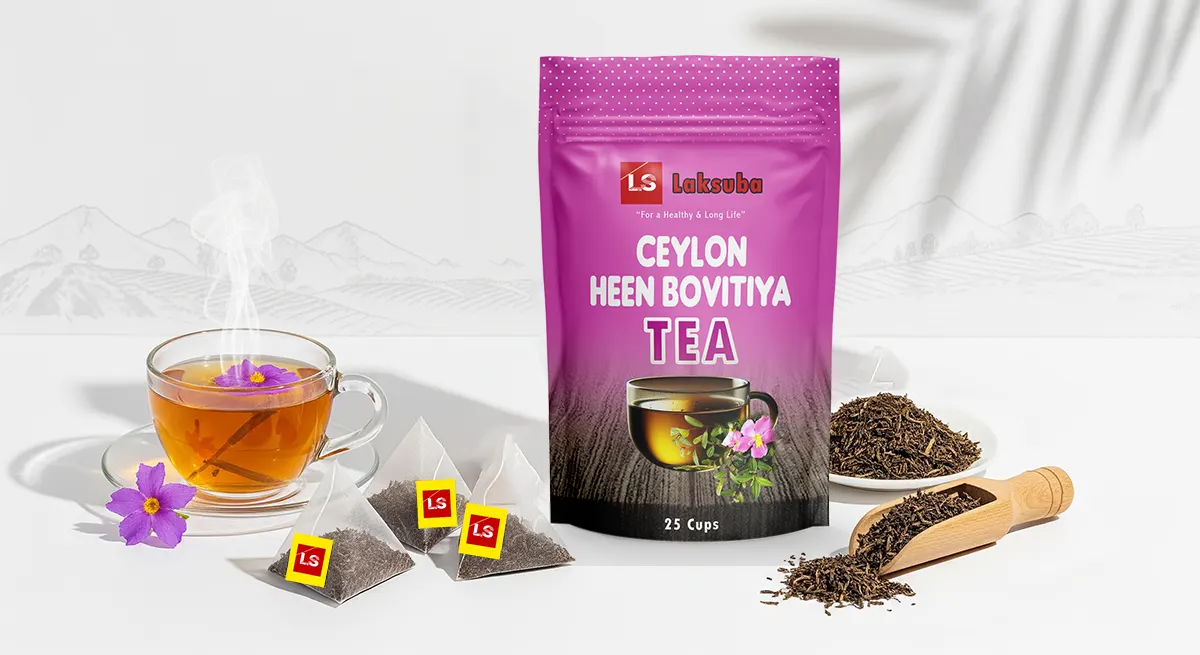
Heen Bovitiya tea gains popularity as a health drink. The pleasant taste appeals to consumers. Marketing emphasizes traditional use and scientific validation.
Product Development: Companies create convenient tea bag products. Some add other herbs for enhanced effects. Organic certification increases market value.
Export Potential: International interest in Ayurvedic products grows. Heen Bovitiya represents authentic Sri Lankan medicine. Export markets include Europe and North America.
Agricultural Opportunities
Farmers can profit from cultivating Heen Bovitiya. The crop requires less investment than many alternatives. Market demand continues increasing.
Contract Farming: Companies establish agreements with farmers. They guarantee purchase at fixed prices. This provides stable income for growers.
Intercropping: Grow Heen Bovitiya between other crops. It uses space efficiently. The plant provides additional income without separate land.
Value Addition: Farmers can process leaves into powder. Dried products have longer shelf life. Processing increases profit margins significantly.
Ornamental Plant Trade
Garden centers increasingly stock native plants. Heen Bovitiya appeals to environmentally conscious gardeners. The ornamental market provides another income stream.
Landscapers use it in sustainable garden designs. Hotels and resorts plant it for authentic Sri Lankan gardens. Public spaces showcase native biodiversity through such plantings.
Future Research Needs
Clinical Studies
More human trials are essential for medical acceptance. Current studies focus on liver disease. Other traditional uses need scientific validation.
Diabetes Research: Controlled trials should test blood sugar effects. Long-term studies would establish safety. Optimal dosing needs determination.
Cancer Studies: Laboratory findings require clinical confirmation. Safety in cancer patients needs assessment. Combination with standard treatments requires investigation.
Mechanism Studies: Researchers must identify active compounds. Understanding how they work guides product development. This knowledge improves therapeutic applications.
Agricultural Research
Better cultivation methods would increase production. Research should focus on practical farming needs.
Yield Improvement: Breeding programs could enhance productivity. Selection for high active compound content is important. Disease-resistant varieties would help farmers.
Organic Farming: Develop organic production protocols. Test natural pest control methods. Organic certification increases product value.
Post-Harvest Technology: Improve drying and storage methods. Develop quality preservation techniques. Better processing maintains therapeutic properties.
Conservation Biology
Long-term species survival requires ongoing research. Climate change impacts need assessment. Population genetics studies guide conservation.
Habitat Requirements: Detailed ecological studies are needed. Understanding specific needs helps conservation planning. Habitat restoration projects need this information.
Climate Adaptation: Study how climate change affects distribution. Identify climate refuges for future conservation. Develop adaptation strategies for cultivation.
Quality Control
Standardization ensures consistent therapeutic effects. Quality parameters need establishment. Testing methods require development.
Active Compound Standards: Define minimum active compound levels. Develop rapid testing methods. Create quality certification systems.
Contamination Testing: Establish pesticide residue limits. Test for heavy metals and microorganisms. Ensure product safety for consumers.
Shelf Life Studies: Determine storage effects on activity. Establish expiration dating guidelines. Optimize packaging for preservation.
Conclusion
Heen Bovitiya stands as a remarkable example of Sri Lanka’s botanical wealth. This endemic plant bridges ancient wisdom and modern science. Traditional healers recognized its value centuries ago. Today, research validates their knowledge with scientific proof.
The plant’s liver-protecting properties offer hope for millions with liver disease. Its anti-cancer effects open new treatment possibilities. The antioxidant power may prevent numerous chronic conditions. These benefits come from a safe, natural source.
Conservation of Heen Bovitiya protects both biodiversity and human health. Sustainable cultivation provides economic opportunities while preserving wild populations. The plant serves multiple roles as medicine, ornamental plant, and conservation symbol.
Future research will reveal more therapeutic applications. Clinical trials will establish its place in modern medicine. Quality control standards will ensure safe, effective products. Agricultural improvements will increase sustainable production.
Communities that cultivate and use Heen Bovitiya maintain cultural connections. They preserve traditional knowledge while embracing scientific validation. This balance between tradition and modernity offers a sustainable healthcare model.
The story of Heen Bovitiya continues evolving. Each research study adds new chapters. Every conservation effort ensures future generations can benefit. This humble plant from Sri Lankan forests may contribute solutions to global health challenges.
Healthcare systems worldwide seek effective, affordable treatments. Natural products like Heen Bovitiya offer promising options. The plant exemplifies how biodiversity serves human welfare. Its protection becomes not just environmental conservation but healthcare security.
As Sri Lanka develops economically, preserving natural heritage gains importance. Endemic plants like Heen Bovitiya represent irreplaceable resources. Their loss would impoverish both nature and human culture. Conservation ensures these treasures remain available forever.
The comprehensive understanding of Heen Bovitiya demonstrates successful biodiversity utilization. Traditional knowledge guided initial recognition of medicinal value. Scientific research confirmed and explained therapeutic effects. Sustainable cultivation meets commercial demands while protecting wild populations.
This integrated approach serves as a model for other medicinal plants. It shows how traditional medicine contributes to modern healthcare. It proves that conservation and development can work together. Most importantly, it demonstrates that nature’s pharmacy remains relevant in the modern world.
Heen Bovitiya’s journey from forest medicine to potential pharmaceutical product inspires continued exploration. Sri Lanka’s endemic plants await similar investigation. Each species may hold keys to treating diseases. Their study honors traditional knowledge while advancing human health.
The responsibility for preserving Heen Bovitiya extends beyond Sri Lanka. This endemic species belongs to global biodiversity heritage. Its conservation contributes to planetary health. Its therapeutic potential could benefit humanity worldwide.
Through understanding, cultivation, and conservation, Heen Bovitiya will continue serving humanity. This remarkable plant embodies the intersection of culture, science, and nature. Its story reminds us that solutions to modern challenges often grow in ancient forests, waiting for respectful discovery and sustainable use.
You might also like to read : Chai Tea: Discover 5 Powerful Benefits and Best in the USA
References
- Leaf extract of Osbeckia octandra induces apoptosis in oral squamous cell carcinoma cells
- A comparative study of the beneficial effects of Osbeckia octandra and Osbeckia aspera in liver dysfunction in rats
- Anti-Fibrotic and Anti-Angiogenic Activities of Osbeckia octandra Leaf Extracts in Thioacetamide-Induced Experimental Liver Cirrhosis
- Leaf Extract of Osbeckia octandra L. (Heen Bovitiya) Suppresses Human Oral Squamous Cell Carcinoma Cells Migration and Induces Cellular DNA Damage
- Phytochemical evaluation, in-vitro radical scavenging and antioxidant activities of aqueous leaf extract of Heen Bovitiya (Osbeckia octandra L. (DC.) grown in Sri Lanka
- Protective effects of Osbeckia octandra against galactosamine and tert-butyl hydroperoxide induced hepatocyte damage
- In vitro antioxidant effects and in vivo hepatoprotective effects of Osbeckia octandra, Vernonia cinerea and Atalantia ceylanica on a high fat diet induced metabolic dysfunction-associated steatotic liver disease mouse model
- Comprehensive Evaluation of Antioxidant Potential of Selected Osbeckia species and their in vitro Culture, Purification and Fractionation
- Osbeckia
- Phenolic and Terpenoid Constituents from the Sri Lankan Medicinal Plant Osbeckia aspera
- Oleanolic, Ursolic, and Betulinic Acids as Food Supplements or Pharmaceutical Agents for Type 2 Diabetes: Promise or Illusion?
- Ursolic, oleanolic and betulinic acids: antibacterial spectra and selectivity indexes
- Activity of Anthracenediones and Flavoring Phenols in Hydromethanolic Extracts of Rubia tinctorum against Grapevine Phytopathogenic Fungi
- Quantitative Determination of Marker Compounds and Fingerprint Analysis of the Seeds of Vernonia anthelmintica
- Establishment of an HPLC Fingerprint and Cluster Analysis for Miao Ethnic Medicine Osbeckia opipara
- GC-MS/HPLC Profiling and Sono-Maceration Mediated Extraction of Osbeckia Parvifolia Polyphenols: In Silico and In Vitro Analysis on Anti-Proliferative Activity in Ovarian Cancer Cell Lines
- Terpenes and terpenoids as main bioactive compounds of essential oils, their roles in human health and potential application as natural food preservatives
- Antidiabetic Activity of Widely Used Medicinal Plants in the Sri Lankan Traditional Healthcare System: New Insight to Medicinal Flora in Sri Lanka
- The use of herbal medicines during breastfeeding: a population-based survey in Western Australia
- Protective effects of Osbeckia octandra against paracetamol-induced liver injury
- High-frequency adventitious shoot organogenesis from in vitro stem explants of Scutellaria araxensis Grossh
- EFFECTS OF HORMONES (IBA & IAA) ON THE PROPAGATION OF HIMALAYAN YEW IN PAKISTAN: A CONSERVATION APPROACH
- Development of an effective propagation protocol for Osbeckia octandra (L.) DC. (Heen Bovitiya)
- Urban Green Spaces: Bridging cultural, ecological and political planning gaps to make the city of Colombo a leading ‘Greener-City’
- Endemic plants in sri lanka
- Landscape ecology and urban biodiversity in tropical Indonesian cities
- Landscape Division University of Peradeniya
- Buzz-pollination in tropical Melastomataceae
- Family Melastomatacaeae Sri Lankan context
- GUIDE TO THE GENERA OF LIANAS AND CLIMBING PLANTS IN THE NEOTROPICS
- OSBECKIA OCTANDRA: A POTENTIAL SHRUB FOR URBAN ENVIRONMENT
- The Therapeutic Potential of Osbeckia Octandra—A Comprehensive Review of its Antidiabetic and Other Pharmacological Properties
- Botanical Extracts Market Size, Share, and Trends 2025 to 2034
- Botanical Extracts Market Size, Share & Industry Analysis, By Source (Spices, Herbs, Flowers, Leaves, and Others), By Technology (CO2 Extraction, Solvent Extraction, Steam Distillation, Enfleurage, and Others), By Application (Food & Beverages, Pharmaceutical and Nutraceutical, and Cosmetics), and Regional Forecast, 2025-2032
- Profitability options of medicinal plants production under risk: Understanding from Aloe vera, Bombax ceiba root and Withania somnifera cultivation in North-West Region, Bangladesh
- Value Chain Analysis for Medicinal Plant based products in India: Case Study of Uttarakhand
- A systematic review of pharmaceutical price mark-up practice and its implementation
- Growing wealth from nature: analyzing the profitability and determinants of high-value medicinal plants in smallholder production systems
- Vitamins & Minerals – Sri Lanka
- Global trade of medicinal and aromatic plants. A review
- Editorial: Drug development of herbal medicines: Regulatory perspectives
- Nutraceuticals and Lead Medicinal Compounds from Sri Lankan Endemic Bioresources: A Science for Policy Perspective
- Factors associated with the export of traditional Chinese medicinal products: A stochastic frontier analysis
- An overview of some important deliberations to promote medicinal plants cultivation
- Pharmaceuticals – Sri Lanka
- Production and Quality Evaluation of Herbal Tea Mixtures from Phyllanthus debilis, Osbeckia octandra, and Artocarpus heterophyllus Leaves
- Pharmacogenomics Implications of Using Herbal Medicinal Plants on African Populations in Health Transition
- Synthetic Biology to Enrich Our Understanding of Plant Physiology and Metabolism
- Nanomaterials for delivery of medicinal plant extracts and phytochemicals: Potential applications and future perspectives
- Herbal medicine in the modern age: The era of personalized precision
- Synthetic biology for plant genetic engineering and molecular farming
- Plant Synthetic Metabolic Engineering for Enhancing Crop Nutritional Quality
- Review of Personalized Medicine and Pharmacogenomics of Anti-Cancer Compounds and Natural Products
- CRISPR/Cas9 in plant biotechnology: applications and challenges
- The Emerging Role of Omics-Based Approaches in Plant Virology
- Artificial Intelligence (AI) Applications in Drug Discovery and Drug Delivery: Revolutionizing Personalized Medicine
- From single- to multi-omics: future research trends in medicinal plants
- Plant Metabolomics: Current Initiatives and Future Prospects
- Integration of Herbal Medicine into Evidence-Based Clinical Practice
- Integration of AI and traditional medicine in drug discovery
- A scoping review of five selected underutilized medicinal plants of Sri Lanka: Focusing on ethnobotany, phytochemistry and bioactivities, and evaluation of their potential for novel herbal product development
- Unraveling the specialized metabolic pathways in medicinal plant genomes: a review
- Omics approaches in understanding the benefits of plant-microbe interactions
- Artificial Intelligence in Natural Product Drug Discovery: Current Applications and Future Perspectives

